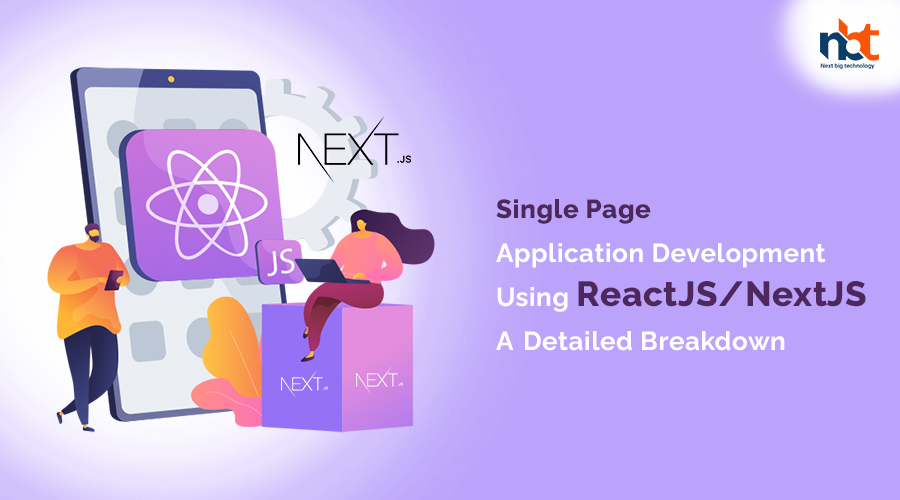Table of Contents
Introduction:
Single Page Applications (SPAs) have gained immense popularity due to their seamless user experience and improved performance. ReactJS and NextJS, two powerful JavaScript frameworks, have emerged as the go-to choices for building SPAs. In this blog, we will provide a detailed breakdown of single page application development using ReactJS and NextJS, exploring each aspect to help businesses understand the benefits and considerations of this approach.
ReactJS and NextJS Overview:
a) ReactJS:
ReactJS is a JavaScript library developed by Facebook that allows developers to build reusable UI components. It uses a virtual DOM (Document Object Model) to efficiently update and render components, resulting in faster and more responsive user interfaces.
b) NextJS:
NextJS is a popular framework built on top of ReactJS that adds server-side rendering (SSR) and other powerful features to enhance React-based applications. It simplifies routing, enables server-side rendering for improved SEO and initial load times, and provides efficient data fetching capabilities.
Component-Based Architecture:
ReactJS and NextJS follow a component-based architecture, where the application is divided into reusable UI components. This modular approach allows developers to build complex UIs by composing smaller, self-contained components, promoting reusability and maintainability.
Virtual DOM and Efficient Rendering:
ReactJS’s virtual DOM allows for efficient updates and rendering of components. Instead of re-rendering the entire page when changes occur, ReactJS updates only the affected components, minimizing unnecessary re-rendering and improving overall performance.
Routing and Navigation:
NextJS simplifies routing in SPAs by providing built-in routing capabilities. Developers can define routes and associate them with specific components, making navigation between different pages seamless. NextJS also supports dynamic routing, allowing for the creation of dynamic and parameterized URLs.
Server-Side Rendering (SSR):
NextJS introduces server-side rendering, where the initial rendering of the application occurs on the server before being sent to the client. This improves the initial load time and enables search engine crawlers to index the content effectively, improving SEO.
Data Fetching:
ReactJS and NextJS provide flexible options for data fetching. ReactJS uses libraries like Axios or Fetch API to fetch data from APIs asynchronously. NextJS offers server-side data fetching through APIs like getStaticProps and getServerSideProps, enabling pre-rendering of data on the server before sending it to the client.
State Management:
ReactJS provides state management through the use of hooks, such as useState and useContext, to manage and share state between components. For more complex state management, popular libraries like Redux and MobX can be integrated into ReactJS applications.
SEO Optimization:
NextJS’s server-side rendering capability enables better SEO optimization, as search engines can crawl and index the fully rendered HTML content. This improves discoverability and visibility of SPAs in search engine results.
Progressive Web Application (PWA) Features:
ReactJS and NextJS support the development of Progressive Web Applications (PWAs). PWAs offer app-like experiences, including offline capabilities, push notifications, and device integration. Service workers, a key feature of PWAs, can be implemented using NextJS’s built-in support or libraries like Workbox.
Deployment and Scalability:
ReactJS and NextJS applications can be deployed to various hosting platforms, such as AWS, Firebase, or Vercel. The modular nature of ReactJS and the optimized rendering provided by NextJS enable scalability and efficient resource utilization.
Conclusion:
Single Page Application development using ReactJS and NextJS offers businesses a powerful and efficient approach to building modern web applications. The component-based architecture, efficient rendering through virtual DOM, server-side rendering capability, and flexible data fetching options make ReactJS and NextJS ideal choices for SPAs. By leveraging these frameworks, businesses can deliver seamless user experiences, improve performance, and achieve better SEO optimization. By partnering with experienced ReactJS and NextJS developers, businesses can harness the full potential of these frameworks and create dynamic, interactive, and scalable single page applications that meet their specific needs in the competitive digital landscape.

















